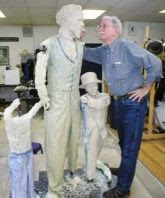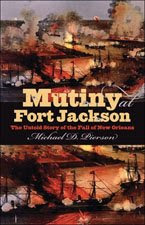 Out of Ammunition
Out of Ammunition, Kim Fernandez, National Parks Conservation Association Newsletter, Spring, 2008.
When privately held land inside a national park draws the eye of a developer, the character of these special places can quickly be lost. And if the Park Service doesn’t receive the funds to purchase the land, the results could be tragic.
You’re tracing the footsteps of the Continental Army across Valley Forge National Historical Park, soaking in the history, picturing what went on there. Your feet stumble on the same bumps and grooves that Washington’s men trod upon during the Revolutionary War. You pause for a moment to drink in the beauty of the Schuylkill River, where hungry soldiers caught American shad swimming upriver in spring. Engrossed in thought, you come to the top of a small hill, look up, and find yourself facing the brick walls and insulated windows of a… conference center. And a hotel. And a massive parking lot.
Ridiculous, right? Think again. Barring a successful lawsuit to stop it, a development just like that will be built on a 78-acre parcel of land at Valley Forge National Historical Park that was sold to developers last year.
“You’ll see this big, huge parking lot from many points in the park,” says Deirdre Gibson, chief of planning and resource management at Valley Forge. “From the land that adjoins it and from the area around the Schuylkill River, you’ll be looking down at it. You’ll see buildings, you’ll see all the lights at night. You’ll look at this and wonder how anyone could have ever supported it.”
It’s precisely the scenario that park rangers and protection groups have worried about for decades, just as funding to acquire private plots or “inholdings” has dried up. Park advocates say more congressional funding of the federal Land and Water Conservation Fund (LWCF) is crucial to their preservation efforts. The principal source of funding for parkland acquisition, LWCF has seen a significant decline in congressional appropriations since 2002 and is now little more than a trickle. Park preservationists say that boosting funding in the next few years could help save historically critical sections of parks currently threatened by development and help preserve parkland that is vital to wildlife habitat and crucial to its historic character.
“Most people are surprised to learn that there are nearly 2 million acres of land inside the boundaries of national parks that are not federally owned,” says Joy Oakes, senior director of NPCA’s Mid-Atlantic regional office. “Because park boundaries often result from political compromise, they’re seldom sufficient to fully protect the resources at risk, so it’s absolutely critical to protect as much land as possible.”
But all too often, funding falls short. The maps of dozens of parks resemble Swiss cheese because of the number of privately held parcels remaining inside their boundaries. The threat that these parcels might be sold to developers for commercial or residential structures is a very real one. After all, the federal budget is tight, and few altruistic private citizens have the resources to snap up those plots themselves and donate them to the National Park Service.
“It’s a big concern for us,” says Robert K. Sutton, chief historian for the National Park Service. “Unfortunately, it’s something we may have to live with.” Before rising to his current post in 2007, Sutton spent 12 years at Manassas National Battlefield Park, where one of his biggest priorities was keeping obtrusive development from ruining views of the park—no simple task in an area being transformed from a quiet and sleepy town to a suburb of Washington, D.C. Sutton and others in the Park Service are still concerned that potential development around several major Mid-Atlantic parks might start creeping in over the next several years, destroying historic land and altering the feel of the parks themselves.

Even at Antietam National Battlefield—one of the best examples of private-public partnerships working toward preservation—several private homes dot the park’s landscape. “Washington County is very attractive to folks who move up here from metro areas,” says the park’s superintendent, John Howard. “They perceive that they’ll be able to buy more house for the money.”
Although construction is prohibited on most of the land inside and immediately adjacent to Antietam, housing and commercial developments just beyond the park’s view have meant a boom in the numbers of people using its land. As population centers continue to expand and technology allows people to work from home, external pressures on parkland will continue to grow. Howard is also concerned that plans for new high-tension power lines up the East Coast could have an effect on Antietam. For now, the lines are planned to cross near the park, in an area that can be seen from the battlefields; construction is scheduled to begin in 2010.
“This could impact about 35 national historical areas on the East Coast,” says Howard. “We’ve met with the various power companies that are involved and talked to them. But it’s got to cross Antietam Valley somewhere, and 95 percent of that area would impact views at the park.” (The proposed energy corridors are extremely controversial, and NPCA is working to protect park interests as the issue moves forward; see “Forum,” Fall 2007.) Howard is thankful that Antietam is one of the country’s most protected parks in terms of development threats. But other parks in the region aren’t so lucky.
Fredericksburg & Spotsylvania National Military Park lies in another recently suburbanized area near Washington, D.C. Here, officials are worried that the limited number of protected acres might mean acres of land will be plundered in the name of improvement. “The Chancellorsville battlefield is one of four that make up the park, and only about 10 to 12 percent of that field is actually protected,” says Jim Campi, policy and communications director with the Civil War Preservation Trust (CWPT). “That’s a result of boundary decisions that were made more than a decade ago—Congress was only willing to put so many acres inside the park. Because of that, there’s an alarming amount of development already standing on historic land in the area. “A good part of the Fredericksburg battlefield is gone,” he says. Almost all of the Union part of the battlefield has been lost.

“This is one of many national military parks that was created under the false assumption that the land would always be farmland and that we only needed to protect earthworks and parts that were monuments. That has definitely turned out not to be the case.” Groups like CWPT have worked to save bits of land—50 acres here, 100 acres there—through private fundraising and private-public partnership grant programs. In Fredericksburg and Chancellorsville, CWPT has saved more than 500 acres from development.
“Since 1999, the Trust has saved four times the amount of battlefield land that the National Park Service has [during the same time period],” says Campi. Even with that track record, he says the race is on to snatch up as much land as possible before it’s bulldozed. “If federal and state funds continue to be available, then we think we can protect the most important pieces,” he says. “But even then, it’s a race against time.”
No one is more familiar with that pressure than the staff at Valley Forge, which now waits to learn the outcome of a lawsuit that NPCA filed to stop the planned construction of a conference center, hotel, and museum in one of the park’s largest remaining inholdings. “I have a sick feeling about this project,” says planning and resource management chief Gibson. “It’s unbelievable. [This land tells] an important part of the Valley Forge story; it’s actually part of the encampment. It’s just the wrong place for something like this. We’d always assumed we’d be able to acquire this property. We never dreamed this would happen.”
NPCA’s Oakes says that park advocates have been working to acquire the property for several years, but the limited LWCF funding approved by Congress was earmarked for other projects. “When you visit historic places, it’s nearly impossible to imagine the characters and events of history if you have to ‘imagine away’ all the modern developments,” says Oakes. “If we don’t find a way to protect these lands today, it will only be a matter of time until we realize the magnitude of the mistake.”

Meanwhile, in West Virginia, lovers of Harpers Ferry are hard at work with local landowners and governments to preserve more than 600 acres of battlefield land that are privately owned. It’s been a 20-year effort, says Scot Faulkner, president of the Friends of Harpers Ferry National Historic Park. The property in question is being acquired by a company that proposes to build a visitor center and other structures to serve park visitors. “We’ve worked with other local and national groups and local residents to preserve 1,800 acres,” Faulkner says, “and we’ve almost doubled the size of this park, but we still have work to do.” Across the country, there are many examples of public-private partnerships saving land inside and next to national parks. But at the same time, a lack of federal funding in recent years makes the “public” part of the partnership woefully inadequate in most cases.
The most logical place to change that is to ensure that Congress returns to the original purpose of the Land and Water Conservation Fund—guaranteeing that our parks and public lands do what they were created to do. NPCA is now launching a campaign to draw attention to this issue with a report documenting precisely what’s at risk (available at www.npca.org).
“Members of Congress and the President must fund the Park Service at the appropriate level,” says Faulkner. “We’ve got to make up for lost time.” In the back of their minds, the staff at Utah’s Zion National Park always feared that someone would step in and develop some of the 3,100 acres of private land within the park; they even developed a land-protection plan to guide them in case that ever happened. But when it did happen, they found there was little they could actually do about it.
According to Superintendent Jock Whitworth, a family purchased four 5-acre tracts of land in 2005, turning one small, dilapidated building into a fairly large house, and advertising the property for use in spiritual retreats. Although crowds haven’t descended on the building, Whitworth says that it and several outbuildings and recreational vehicles parked on the property and the adjacent tract have disrupted “one of the most spectacular views in the country.” There was little the Park Service could do to stop that development, but officials are currently considering the landowner’s offer to sell his two remaining parcels.
“We’re taking steps toward the process, if we can find the money,” says Whitworth, but the larger fear is that other property owners inside the park might see this example and find development more attractive. Whitworth is waiting for a final appraisal of the landowner’s remaining 10 acres and investigating funding. Although he’s optimistic that the Park Service might be able to buy the property, there is one major stumbling block: “At the current time,” he says, “there just isn’t any money.”
Kim Fernandez is a freelance writer living in Bethesda, Maryland.
Thoughts about this article? Comments you'd like to share with the editors? Send an e-mail to npmag@npca.org, and we'll consider printing your letter in the next issue of National Parks magazine. Include your name, city, and state. Published letters may be edited for length and clarity.
Text Source:
http://www.npca.org/magazine/2008/spring/out-of-ammunition.html?print=t Photos
Photos: Top: Sunrise at Harpers Ferry National Park (NPS)
Bottom: Kirkland Memorial at Fredericksburg National Military Park. (NPS)
































